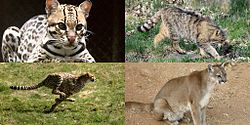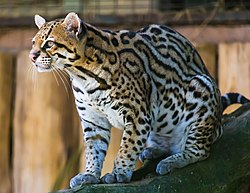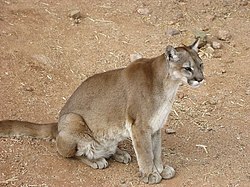Felinae
 From Wikipedia - Reading time: 18 min
From Wikipedia - Reading time: 18 min
| Felinae[1] | |
|---|---|

| |
| Clockwise, an ocelot, a European wildcat, a cougar and a cheetah | |
| Scientific classification | |
| Domain: | Eukaryota |
| Kingdom: | Animalia |
| Phylum: | Chordata |
| Class: | Mammalia |
| Order: | Carnivora |
| Suborder: | Feliformia |
| Family: | Felidae |
| Subfamily: | Felinae Fischer von Waldheim, 1817 |
| Type genus | |
| Felis | |
| Genera | |
|
See §Taxonomy | |

| |
| Native ranges of Felinae | |
The small cats or Felinae are a subfamily of Felidae distinguished by their bony hyoids, which let them purr but not roar.[2] Other authors have proposed an alternative definition for this subfamily, as comprising only the living conical-toothed cat genera with two tribes, the Felini and Pantherini, and excluding the extinct sabre-toothed Machairodontinae.[3][4]
Characteristics
[edit]The members of the Felinae have retractile claws that are protected by at least one cutaneous lobe. Their larynx is kept close to the base of the skull by an ossified hyoid.[5] They can purr owing to the vocal folds being shorter than 6 mm (0.24 in).[6][7] The cheetah Acinonyx does not have cutaneous sheaths for guarding claws.[8]
Taxonomy
[edit]The term 'Felini' was first used in 1817 by Gotthelf Fischer von Waldheim, at the time for all the cat species that had been proposed as belonging to the genus Felis.[9] In 1917, Reginald Innes Pocock also subordinated the following genera to the Felinae that had been proposed in the course of the 19th century: Lynx, Puma, Leptailurus, Prionailurus, Pardofelis, Leopardus, Herpailurus, Neofelis and four more.[5]
The Felinae and Pantherinae probably diverged about 11.5 million years ago. The genera within the Felinae diverged between 10.67 and 4.23 million years ago.[10][11]
Today, the following living genera and species are recognised as belonging to the Felinae:[2]
Extinct taxa
[edit]| Genus | Species | Image |
|---|---|---|
| Felis | ||
| Acinonyx | ||
| Lynx | ||
| Puma | ||
| Leopardus | ||
| Leptofelis Salesa et al., 2017 |
|
|
| Miracinonyx Adams, 1979[52] |
|

|
| Pratifelis Hibbard, 1934 |
|
|
| Pristifelis Salesa et al., 2012 |
|
|
| Sivapanthera Kretzoi, 1929[53] |
|
|
| Sivapardus Bikr, 1969[citation needed] |
|
|
| Vishnufelis Pilgrim, 1932 |
|
Phylogeny
[edit]The phylogenetic relationships of Felinae are shown in the following cladogram:[54][55][2]
| Felinae |
| ||||||||||||||||||||||||||||||||||||||||||||||||||||||||||||||||||||||||||||||||||||||||||||||||||||||||||||||||||||||||||||||||||||||||||||||||||||||||||||||||||||||||||||||||||||||||||||||||||||||||||||||||||||||||||||||||||||||||||||||||||||||||||||||||||||||||||||||||||||||||||||||||||||||
sensu lato
|
See also
[edit]References
[edit]- ^ Wozencraft, W. C. (2005). "Felinae". In Wilson, D. E.; Reeder, D. M. (eds.). Mammal Species of the World: A Taxonomic and Geographic Reference (3rd ed.). Johns Hopkins University Press. pp. 532–545. ISBN 978-0-8018-8221-0. OCLC 62265494.
- ^ a b c Kitchener, A. C.; Breitenmoser-Würsten, C.; Eizirik, E.; Gentry, A.; Werdelin, L.; Wilting, A.; Yamaguchi, N.; Abramov, A. V.; Christiansen, P.; Driscoll, C.; Duckworth, J. W.; Johnson, W.; Luo, S.-J.; Meijaard, E.; O’Donoghue, P.; Sanderson, J.; Seymour, K.; Bruford, M.; Groves, C.; Hoffmann, M.; Nowell, K.; Timmons, Z.; Tobe, S. (2017). "A revised taxonomy of the Felidae: The final report of the Cat Classification Task Force of the IUCN Cat Specialist Group" (PDF). Cat News. Special Issue 11: 11−63.
- ^ Werdelin, L.; Yamaguchi, N.; Johnson, W. E.; O'Brien, S. J. (2010). "Phylogeny and evolution of cats (Felidae)". In Macdonald, D. W.; Loveridge, A. J. (eds.). Biology and Conservation of Wild Felids. Oxford, UK: Oxford University Press. pp. 59–82. ISBN 978-0-19-923445-5.
- ^ Werdelin, L. (2013). "Subfamily Felinae − Cats". In Kingdon, J.; Happold, D.; Butynski, T.; Hoffmann, M.; Happold, M.; Kalina, J. (eds.). Mammals of Africa. Vol. 5. London, UK: Bloomsbury Publishing. pp. 144–210. ISBN 978-1-4081-2251-8.
- ^ a b Pocock, R. I. (1917). "The classification of the existing Felidae". Annals and Magazine of Natural History. Series 8. XX (119): 329–350. doi:10.1080/00222931709487018.
- ^ Hast, M. H. (1989). "The larynx of roaring and non-roaring cats". Journal of Anatomy. 163: 117–121. PMC 1256521. PMID 2606766.
- ^ Peters, G. (2002). "Purring and similar vocalizations in mammals". Mammal Review. 32 (4): 245−271. doi:10.1046/j.1365-2907.2002.00113.x.
- ^ Pocock, R. I. (1917). "VII.—On the external characters of the Felidæ". The Annals and Magazine of Natural History; Zoology, Botany, and Geology. 8. 19 (109): 113−136. doi:10.1080/00222931709486916.
- ^ Fischer, G. (1817). "Adversaria Zoologica. Fasciculus primus. Quaedam ad Mammalium systema et genera illustranda". Mémoires de la Société Impériale des Naturalistes de Moscou. 5: 357−446.
- ^ Johnson, W. E.; Eizirik, E.; Pecon-Slattery, J.; Murphy, W. J.; Antunes, A.; Teeling, E. & O'Brien, S. J. (2006). "The Late Miocene radiation of modern Felidae: A genetic assessment". Science. 311 (5757): 73–77. Bibcode:2006Sci...311...73J. doi:10.1126/science.1122277. PMID 16400146. S2CID 41672825.
- ^ Li, G.; Davis, B. W.; Eizirik, E.; Murphy, W. J. (2016). "Phylogenomic evidence for ancient hybridization in the genomes of living cats (Felidae)". Genome Research. 26 (1): 1−11. doi:10.1101/gr.186668.114. PMC 4691742. PMID 26518481.
- ^ Brookes, J. (1828). "Section Carnivora". A catalogue of the Anatomical and Zoological Museum of Joshua Brookes. London: Richard Taylor. p. 16.
- ^ Schreber, J. C. D. (1777). "Der Gepard". Die Säugthiere in Abbildungen nach der Natur mit Beschreibungen (Dritter Theil). Erlangen: Wolfgang Walther. pp. 392–393.
- ^ Gray, J. E. (1843). "Felidae". List of the specimens of Mammalia in the British Museum. London: The British Museum. pp. 39–46.
- ^ Schreber, J. C. D. (1777). "Der Karakal". Die Säugethiere in Abbildungen nach der Natur mit Beschreibungen. Erlangen: Wolfgang Walther. pp. 413–414.
- ^ Temminck, C. J. (1827). "Félis doré Felis aurata". Monographies de Mammalogie. Paris: G. Dufour et E. d'Ocagne. pp. 120−121.
- ^ a b c d e Severtzow, M. N. (1858). "Notice sur la classification multisériale des Carnivores, spécialement des Félidés, et les études de zoologie générale qui s'y rattachent". Revue et Magasin de Zoologie Pure et Appliquée. X: 385–396.
- ^ a b Vigors, N. A.; Horsfield, T. (1827). "Descriptions of two species of the genus Felis, in the collections of the Zoological Society". The Zoological Journal. III (11): 449–451.
- ^ Gray, J. E. (1874). "Description of a new Species of Cat (Felis badia) from Sarawak". Proceedings of the Scientific Meetings of the Zoological Society of London for the Year 1874: 322–323.
- ^ a b Linnaeus, C. (1758). "Felis". Systema naturae per regna tria naturae: secundum classes, ordines, genera, species, cum characteribus, differentiis, synonymis, locis (in Latin). Vol. 1 (Tenth reformed ed.). Holmiae: Laurentii Salvii. pp. 42–44.
- ^ Schreber, J. C. D. (1778). "Die wilde Kaze" [The wild Cat]. Die Säugthiere in Abbildungen nach der Natur mit Beschreibungen (Dritter Theil). Erlangen: Expedition des Schreber'schen Säugthier- und des Esper'schen Schmetterlingswerkes. pp. 397–402.
- ^ Schreber, J. C. D. (1778). "Der Kirmyschak". Die Säugethiere in Abbildungen nach der Natur, mit Beschreibungen. Erlangen: Wolfgang Walther. pp. 414–416.
- ^ Forster, G. R. (1780). "LIII. Der Karakal". Herrn von Büffons Naturgeschichte der vierfüssigen Thiere. Mit Vermehrungen, aus dem Französischen übersetzt. Sechster Band [Mr. von Büffon‘s Natural History of Quadrupeds. With additions, translated from French. Volume 6]. Berlin: Joachim Pauli. pp. 299–319.
- ^ Burchell, W. J. (1824). "Felis nigripes". Travels in the Interior of Southern Africa, Vol. II. London: Longman, Hurst, Rees, Orme, Brown, and Green. p. 592.
- ^ Loche, V. (1858). "Description d'une nouvelle espèce de Chat par M. le capitaine Loche" [Description of a new species of cat, Mr. Captain Loche]. Revue et Magasin de Zoologie Pure et Appliquée. 2. X: 49–50.
- ^ Milne-Edwards, A. (1892). "Observations sur les mammifères du Thibet". Revue Générale des Sciences Pures et Appliquées. III: 670–671.
- ^ Geoffroy St. Hilaire, É. (1803). "Le Chat Yagouarundi Felis yagouarundi". Catalogue des Mammifères du Muséum National d'Histoire Naturelle. Paris, France: Museum National d'histoire naturelle. p. 124.
- ^ Gray, J. E. (1842). "Descriptions of some new genera and fifty unrecorded species of Mammalia". Annals and Magazine of Natural History. 10 (65): 255−267. doi:10.1080/03745484209445232.
- ^ Linnaeus, C. (1758). "Felis pardalis". Systema naturae per regna tria naturae: secundum classes, ordines, genera, species, cum characteribus, differentiis, synonymis, locis. Vol. I (Tenth ed.). Holmiae: Laurentius Salvius. p. 42.
- ^ Schreber, J. C. D. (1778). "Die Maragua". Die Säugethiere in Abbildungen nach der Natur, mit Beschreibungen. Erlangen: Wolfgang Walther. pp. 396–397.
- ^ a b Molina, G. I. (1782). "La Guigna Felis guigna". Saggio sulla storia naturale del Chilli. Bologna: Stamperia di S. Tommaso d’Aquino. p. 295. Archived from the original on 2019-06-08. Retrieved 2020-08-06.
- ^ Schinz, H. R. (1821). "Wiedische Katze Felis wiedii". Das Thierreich eingetheilt nach dem Bau der Thiere: als Grundlage ihrer Naturgeschichte und der vergleichenden Anatomie von dem Herrn Ritter von Cuvier. Säugethiere und Vögel, Volume 1. Stuttgart, Tübingen: Cotta. pp. 235–236.
- ^ D'Orbigny, A.; Gervais, P. (1844). "Mammalogie: Nouvelle espèce de Felis". Extraits des Procès-verbaux des Séances. 9: 40−41.
- ^ Cornalia, E. (1865). "Descrizione di una nuova specie del genere Felis. Felis jacobita (Corn.)". Memorie della Societá Italiana di Scienze Naturali. 1: 3−9.
- ^ Hensel, R. (1872). "Beiträge zur Kenntniss der Säugethiere Süd-Brasiliens". Physikalische Abhandlungen der Königlichen Akademie der Wissenschaften zu Berlin (1873): 1−130.
- ^ Schreber, J. C. D. (1778). "Der Serval". Die Säugethiere in Abbildungen nach der Natur, mit Beschreibungen. Erlangen: Wolfgang Walther.
- ^ a b Kerr, R. (1792). "F. Lynx canadensis". The Animal Kingdom or zoological system of the celebrated Sir Charles Linnaeus. Class I. Mammalia. Edinburgh & London: A. Strahan & T. Cadell. p. 157−158.
- ^ Linnaeus, C. (1758). "Felis lynx". Caroli Linnæi Systema naturæ per regna tria naturæ, secundum classes, ordines, genera, species, cum characteribus, differentiis, synonymis, locis. Vol. Tomus I (decima, reformata ed.). Holmiae: Laurentius Salvius. p. 43.
- ^ Schreber, J. C. D. (1778). "Der Rotluchs". Die Säugethiere in Abbildungen nach der Natur, mit Beschreibungen. Erlangen: Wolfgang Walther. pp. 442–443.
- ^ Temminck, C. J. (1827). "Felis pardina". Monographies de mammalogie, ou description de quelques genres de mammifères, dont les espèces ont été observées dans les différens musées de l'Europe. Vol. 1. Leiden: C. C. Vander Hoek. pp. 116−117.
- ^ Brandt J. F. (1842). "Observations sur le manoul (Felis manul Pallas)". Bulletin Scientifique. Académie Impériale des Sciences de Saint Petersbourg. 9: 37–39.
- ^ Pallas, P. S. (1776). "Felis manul". Reise durch verschiedene Provinzen des russischen Reichs in einem ausführlichen Auszuge. Volume 3. Frankfurt und Leipzig: J. G. Fleischer. p. 490.
- ^ Martin, W. C. (1836). "Description of a new species of Felis". Proceedings of the Zoological Society of London. IV (XLVII): 107–108.
- ^ Kerr, R. (1792). "Bengal Tiger-Cat Felis bengalensis". The Animal Kingdom or zoological system of the celebrated Sir Charles Linnaeus. Class I. Mammalia. Edinburgh & London: A. Strahan & T. Cadell. pp. 151–152.
- ^ Desmarest, A. G. (1816). "Le Chat de Java, Felis javanensis Nob.". In Société de naturalistes et d'agriculteurs (ed.). Nouveau dictionnaire d'histoire naturelle, appliquée aux arts, à l'agriculture, à l'économie rurale et domestique, à la médecine. Tome 6. Paris: Chez Deterville. p. 115.
- ^ Bennett, E. T. (1833). "Felis viverrinus". Proceedings of the Zoological Society of London. Part I: 68–69.
- ^ Geoffroy Saint-Hilaire, I. (1831). "Le Chat à Taches de Rouille, Felis rubiginosa (Nob.)l". In Bélanger, C.; Geoffroy Saint-Hilaire, I. (eds.). Voyage aux Indes-Orientales par le nord de l'Europe, les provinces du Caucases, la Géorgie, l'Arménie et la Perse, suivi des détails topographiques, statistiques et autre sur le Pégou, les Iles de Jave, de Maurice et de Bourbon, sur le Cap-de-bonne-Espérance et Sainte-Hélène, pendant les années 1825, 1826, 1827, 1828 et 1829. Tome 3: Zoologie. Paris: Arthus Bertrand. pp. 140−144.
- ^ Jardine, W. (1834). "Genus II. Puma". Naturalists' library, Mammalia, volume 2. Edinburgh: Lizars, Stirling and Kenney. pp. 266–267.
- ^ Linnaeus, C. (1771). "Felis concolor". Mantissa plantarum altera. Generum editionis VI et specierum editionis II. Regni animalis appendix. Holmiae: Laurentii Salvii. p. 522.
- ^ Stephens, J. J. (1959). "A new Pliocene cat from Kansas". Papers of the Michigan Academy of Science, Arts, and Letters (44): 41–46.
- ^ Werdelin, L. (1981). "The evolution of lynxes" (PDF). Annales Zoologici Fennici (18): 37–71.
- ^ Adams, D. B. (1979). "The Cheetah: Native American". Science. 205 (4411): 1155–1158. Bibcode:1979Sci...205.1155A. doi:10.1126/science.205.4411.1155. PMID 17735054. S2CID 17951039.
- ^ Kretzoi, M. (1929). "Materialien zur phylogenetischen Klassifikation der Ailuroïden". In Csiki, E. (ed.). Xe Congrès international de zoologie, tenu à Budapest du 4 au 10 septembre 1927. Volume 2. Budapest: Imprimerie Stephaneus. pp. 1293−1355.
- ^ Werdelin, L.; Yamaguchi, N.; Johnson, W. E.; O'Brien, S. J. (2010). "Phylogeny and evolution of cats (Felidae)". In Macdonald, D. W.; Loveridge, A. J. (eds.). Biology and Conservation of Wild Felids. Oxford, UK: Oxford University Press. pp. 59–82. ISBN 978-0-19-923445-5.
- ^ Wozencraft, W. C. (2005). "Order Carnivora". In Wilson, D. E.; Reeder, D. M. (eds.). Mammal Species of the World: A Taxonomic and Geographic Reference (3rd ed.). Johns Hopkins University Press. pp. 532–628. ISBN 978-0-8018-8221-0. OCLC 62265494.
External links
[edit] Media related to Felinae at Wikimedia Commons
Media related to Felinae at Wikimedia Commons
 KSF
KSF













